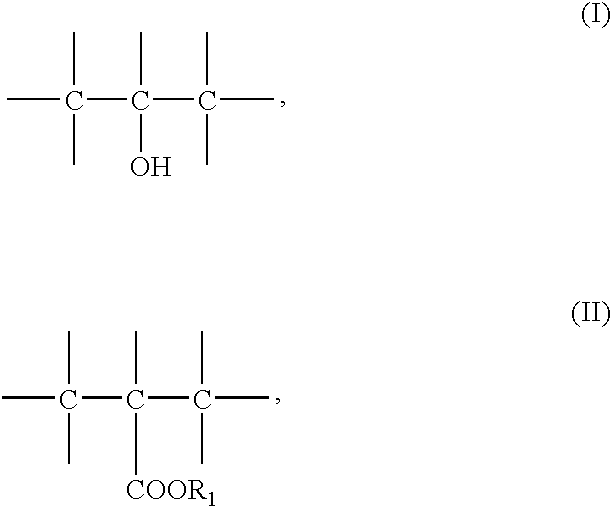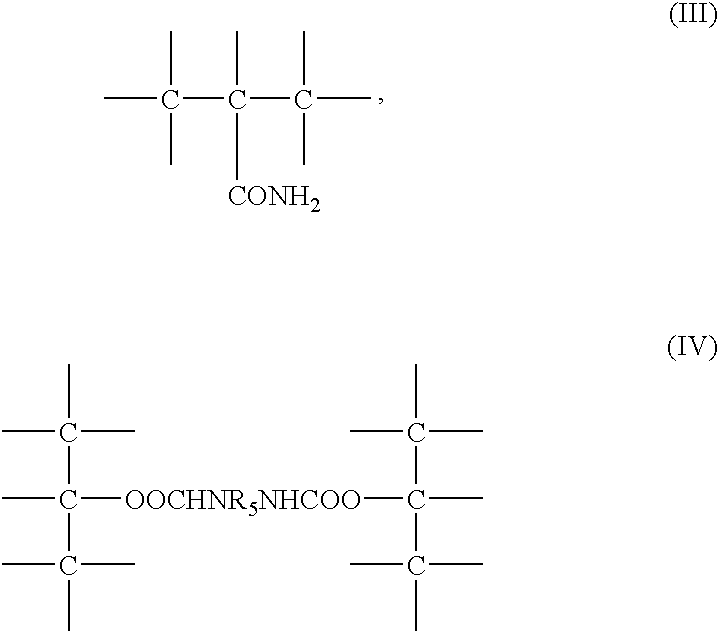However, a toner comprising such a sharp-melting binder resin is liable to cause a problem of high-temperature offset because of low self-cohesion of the binder resin at the time of toner melting in the heat-pressure fixing step.
When such a high-
crystallinity wax is used in a toner for full-
color image formation, however, the fixed toner image is liable to have inferior transparency, thus providing a projected image with lower saturation and brightness when projected as an OHP image, because of the high
crystallinity and difference in
refractive index from an OHP
sheet material of the wax.
However, such waxes cannot fully satisfy all the requirements of transparency for OHP use, and low-temperature fixability and anti-high temperature offset characteristic at the time of heat-pressure fixation.
However, according to the measure, the
resultant fixed image is liable to have excessive oil on its surface, and the oil is liable to soil the photosensitive member by attachment and swell the fixing roller to shorten the life of the roller.
Further, the oil has to be supplied to the fixing roller surface uniformly and at a controlled rate in order to prevent the occurrence of oil lines on the fixed image, and thus tends to require an increase in overall size of the fixing apparatus.
As a result, the
resultant fixed images are liable to have surface unevennesses, to result in a lower transparency for the OHP use.
Moreover, recorded image products obtained by using the toner tend to exhibit low gloss.
This is advantageous for providing graphic images including both graphic images and character images not lacking harmony therebetween but is liable to result in pictorial images with narrow reproduced color ranges because of lower
secondary color mixability due to insufficient toner melting in the fixing step.
%, the
powder blending of the wax and optionally the vinyl resin with the
polyester resin as a principal binder resin is liable to become difficult, so that a preliminary melt-blending or a blending together with
solvent at an elevated temperature becomes necessary.
On the other hand, if the
hydroxyl value exceeds 80 mgKOH / g, the wax is caused to have too strong a polarity on the contrary, thus also exhibiting low
mutual solubility or dispersibility, so that the resultant toner is also liable to result in image defects due to isolation of the wax.
On the other hand, if the maximum heat-absorption peak temperature is above 90.degree. C., the wax cannot be quickly melted to migrate to the fixed image surface at the time of toner image fixation thus being liable to cause high-temperature offset due to a lower releasability.
If the maximum heat-evolution peak temperature is above 90.degree. C., the wax cannot be quickly melted to migrate to the fixed image surface at the time of toner image fixation thus being liable to cause high-temperature offset due to a lower releasability.
An
acid value is a value affecting the
heat resistance, and if the acid value is below 1 mgKOH / g, the wax is liable to show a lower mutual
solubility or dispersibility with the polyester resin as a principal constituent of the binder resin, thus being liable to image defects due to isolation of the wax.
In the case of using a polyester-type resin (in a sense of including a
hybrid resin) as a principal binder resin, a fairly good fixing performance may be obtained by adding a non-polar
hydrocarbon wax, but the wax shows an inferior dispersibility due to poor mutual
solubility with the principal binder resin, thus lowering the developing performance of the resultant toner.
A polar wax may be uniformly dispersed in the binder resin but is liable to fail in providing sufficient fixing performances.
This is presumably because a polar wax shows good dispersibility within a polyester based resin, but a polar group at a terminal of a wax main chain is not as effective as a polar group at a
side chain position for dispersing the colorant and the
charge control agent.
If Tabs.max is below 55.degree. C., the
glass transition temperature (Tg) of the toner is remarkably lowered, and the wax is caused to exude to the toner particle surfaces when allowed to stand in a high temperature environment, thus lowering the anti-blocking performance of the toner.
If Tabs.max exceeds 90.degree. C., the wax cannot migrate to the fixed image surface at the time of fixation, thus being liable to result in a lower releasability leading to high-temperature offset phenomenon.
If Tevo.max is below 45.degree. C., the
glass transition temperature (Tg) of the toner is remarkably lowered, and the wax is caused to exude to the toner particle surfaces when allowed to stand in a high temperature environment, thus lowering the anti-blocking performance of the toner.
If Tevo.max exceeds 90.degree. C., the wax cannot migrate to the fixed image surface at the time of fixation, thus being liable to result in a lower releasability leading to high-temperature offset phenomenon.
% of the toner for causing little change in initial chargeability of the toner, easily providing a necessary charge for the development and thus obviating
image quality deterioration such as
fog and a lowering in
image density.
% or absent in the toner, the toner charge is liable to be lowered in a continuous
image formation, thus being liable to result in lower
image density.
If the ratio Mw / Mn is below 300, the toner is caused to have a smaller amount of high-molecular weight component which is presumably formed as a soft gel formed by crosslinking between the organometallic compound and the resin during hot kneading, thus being liable to cause high-temperature offset.
% in the developer, the toner is liable to damage (abrade) the regulating blade or developer-carrying member surface, thus causing charging failure.
% of the toner, the toner receives an excessively large magnetic constraint force from the developer-carrying roller, thus being liable to result in a lower image density.
If the colorant content exceeds 15 wt. parts, the toner is caused to have a lower transparency and makes it difficult to reproduce an intermediate color as represented by a
human skin color.
Further, as the stability of toner chargeability is lowered, it becomes difficult to obtain an objective charge.
If the colorant content is below 1 wt. part, the colorant is caused to have a lower coloring power, so that it becomes difficult to obtain high quality images having a high image density.
If D4 is below 3.0 .mu.m, the toner is caused to have a lower chargeability, thus being liable to cause
fog or toner scattering in a continual
image formation on a large number of sheets.
If D4 exceeds 15.0 .mu.m, the toner is caused to have a lower reproducibility of
halftone images, thus being liable to result in
halftone images with a rough appearance.
If the application amount exceeds 1.times.10.sup.-7 g / cm.sup.2, the fixed image on the recording material is liable to
glitter, thus lowering the recognizability of character images.
 Login to View More
Login to View More 


